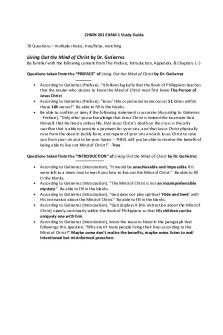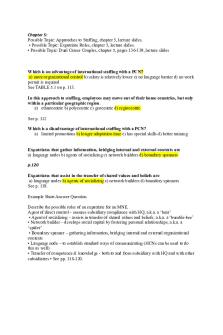PS 201 - Exam 1 - concepts - example questions PDF

| Title | PS 201 - Exam 1 - concepts - example questions |
|---|---|
| Author | zy rules |
| Course | Us Racial & Ethnic Politics |
| Institution | University of Illinois at Urbana-Champaign |
| Pages | 2 |
| File Size | 52.7 KB |
| File Type | |
| Total Downloads | 38 |
| Total Views | 146 |
Summary
assignment...
Description
PS 201: U.S. Racial and Ethnic Politics Spring 2020
EXAM 1 This exam covers material from Modules 1-4, and consists of Identification, Short Answer, and Essay questions. You have one hour to complete the exam. You will have a choice of questions to answer for each section.
Part I. Identification Define and identify the significance of four of the following eight terms/phrases. Each should be answered in two sentences: one sentence for the definition, and one for the significance of the term. Example: ● Relative Deprivation Theory ○ This is a theory that argues that people become discontented when they perceive a gap between the standard of living they are currently enjoying and the standard they believe they should have or hope to be enjoying. It is significant because it is one of the ways to explain ethnocentrism and prejudice. List of possible concepts: ● This is an exhaustive list of IDs. In other words, if a concept does not appear on this list, it will not appear on the exam. 1. American Dilemma 2. Americanization 3. Automatic vs. controlled racial stereotyping 4. Black utility heuristic 5. Bogus pipeline 6. Ethnocentrism 7. Implicit Association Test 8. Implicit racial message 9. Linked fate 10. List experiment 11. Panethnic identity 12. Prerequisite cases 13. Principled Politics 14. Race as a social construct 15. Reactive ethnicity 16. Realistic group conflict theory
PS 201: U.S. Racial and Ethnic Politics Spring 2020
17. Relative deprivation theory 18. Segmented assimilation 19. Social desirability bias 20. Social dominance theory 21. Straightline assimilation 22. Superordinate goals 23. Symbolic racism
Part II. Short-Answer Questions You will be asked to answer two short-answer questions. The responses should be about 3-4 sentences each. Example question: ● LaPiere found that a vast majority of the hotel and restaurant proprietors he surveyed indicated that they would not be willing to serve a Chinese couple, even though all but one had allowed the couple to stay or eat. What affects whether attitudes will be consistent with behavior? What are 3 things about the individual and the environment that can change how attitudes are translated to behavior? Explain using the LaPiere experiment as an example.
Part III. Essay Question You will be asked to answer one essay question. The response should be 4-5 paragraphs. Example question: ● Why does Samuel Huntington (author of Who Are We?) think that today's immigrants are posing problems that the immigrants of the past did not? (1) List at least 3 ways scholars have measured assimilation into American culture. (2) Explain why Huntington thinks Mexican immigration is not like immigration in the early 20th century. And (3) provide arguments other authors have used to make the case that Mexican immigrants are assimilating....
Similar Free PDFs

Example exam questions solutions
- 8 Pages

Concepts for Exam 1
- 3 Pages

Prep-BUL-Example Exam Questions
- 6 Pages

CHMN 201 Exam 1 Guide
- 6 Pages

Accounting 201 Exam 1 Review
- 3 Pages

PS - Wh Questions - exercises
- 1 Pages

PS 210 Exam 1 - class notes
- 16 Pages

Exam 1 study guide BIO 201
- 9 Pages
Popular Institutions
- Tinajero National High School - Annex
- Politeknik Caltex Riau
- Yokohama City University
- SGT University
- University of Al-Qadisiyah
- Divine Word College of Vigan
- Techniek College Rotterdam
- Universidade de Santiago
- Universiti Teknologi MARA Cawangan Johor Kampus Pasir Gudang
- Poltekkes Kemenkes Yogyakarta
- Baguio City National High School
- Colegio san marcos
- preparatoria uno
- Centro de Bachillerato Tecnológico Industrial y de Servicios No. 107
- Dalian Maritime University
- Quang Trung Secondary School
- Colegio Tecnológico en Informática
- Corporación Regional de Educación Superior
- Grupo CEDVA
- Dar Al Uloom University
- Centro de Estudios Preuniversitarios de la Universidad Nacional de Ingeniería
- 上智大学
- Aakash International School, Nuna Majara
- San Felipe Neri Catholic School
- Kang Chiao International School - New Taipei City
- Misamis Occidental National High School
- Institución Educativa Escuela Normal Juan Ladrilleros
- Kolehiyo ng Pantukan
- Batanes State College
- Instituto Continental
- Sekolah Menengah Kejuruan Kesehatan Kaltara (Tarakan)
- Colegio de La Inmaculada Concepcion - Cebu







